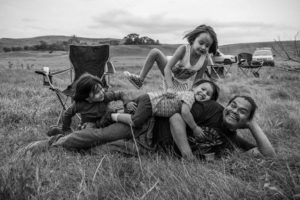
“When one lives in a society where people can no longer rely on the institutions to tell them the truth, the truth must come from culture and art.”
Josué Rivas began his talk at Stanford will these words from John Trudell, renowned Indigenous poet and activist. It’s an affirming statement for a photographer — one who seeks to document the truth for people to see in a way that often elicits strong emotional responses.
Josué Rivas (Mexica/Otomi) is an award-winning documentary photographer, videographer and film director. After his experiences at Standing Rock, Rivas founded the Standing Strong Project — a long-term multimedia project throughout which he intends to explore the complexity of indigenous sovereignty and indigenous identity across the continent. He calls Standing Rock “The Awakening,” and it is the first chapter of the project. As he moves the project forward, Rivas hopes to create spaces and provide tools for more indigenous folks to tell their own stories.
We are now about a year out from the dramatic police clashes, which led to the eviction of water protectors at Standing Rock. Oil is now flowing through the Dakota Access Pipeline, despite fierce resistance from the Standing Rock Sioux tribe, environmentalists and other allies, who fought (and continue fighting) to defend their drinking water and sacred lands. The legal battle over the pipeline is still ongoing, but for Josué Rivas, the events of Standing Rock have come to mean much more than opposition to the Dakota Access Pipeline.
When he first arrived at Oceti Sakowin camp, Rivas intended to stay for a week — he ended up staying for almost seven months. Part of this was his dedication to learning and participating in the story that unfolded at Standing Rock. In contrast with some of the other media personnel who showed up to capture the stories of the water protectors at Standing Rock, Rivas was intentional about giving before he took. Observing tradition, he would show up with tobacco to offer before asking permission to document a person’s experience. Rivas even incorporates this into his language about the work, straying away from the traditional framework of “taking” photos — “because I don’t take. I create. I’m not taking photographs, I’m creating images.”
Rivas also acknowledges that “it’s an intimate thing, when you have a camera.” A photograph belongs both to the subject and the photographer, but the subject is usually in a more vulnerable position — especially in a place like Standing Rock, where people were making sacrifices, and grappling with all sorts of issues and traumas. These wounds are communicated both with tenderness and frankness in Rivas’s work.
“I try to spend a lot of time with people that I’m trying to connect with,” Rivas says of his process. He recalls that, in journalism school, the general rule of thumb was to avoid getting involved with your subjects, to stay unbiased and removed. “And I was like, hold on — I’m human, dude.” This was when Rivas realized that “I’m not a photojournalist. I’m an artist.”
Part of his current expression involves working as creative director for Nahko Bear (of Nahko and Medicine for the People) — an American folk musician and activist. Rivas put together a music video for Nahko’s song “Love Letters to God,” featuring some heavy footage from Standing Rock. He showed this video to the group during his talk, acknowledging that it was still difficult for him to watch. During clashes with the police, many of the water protectors at Standing Rock were maced, hit with rubber bullets or sprayed with cold water so forcefully that it tore skin off their hands and arms.
In plenty of these instances, Rivas was faced with a dilemma about whether to create an image or put away his camera and help somebody in harm’s way. Showing photographs of people in distress, he related: “My spirit had to stay strong in order to create an image like this.” His intuition told him it was the right thing to do at the time. Rivas likened some of these chilling photos to famous pictures from the civil rights movement, when protesters suffered violence at the hands of police. He believes that someday we will look back at pivotal images like these and think, “how were we doing this stuff to people? It’s not human.”
Rivas’s photography, on the other hand, is extremely human. Although not all of his images have people as the subject, they are all closely related to the human experience, and particularly the experience of native people. Rivas showed one photograph of a Lakota man, lying in the grass, a smile on his face as his three children clamber on top of him — Rivas took this photo at a healing gathering several months after the camps were cleared out by police. No one is wearing feathers or other ceremonial garb. There are no horses or tipis in the photo. Defying stereotypes of indigenous people, and the conventional mold for portrayal of indigenous people in the media, the photo shows a simple human moment between a father and his children.
Rivas spoke with compassion about the police as well, not all of whom were villains. He told the group that many of the officers resigned after the clashes at Standing Rock, and recalled seeing some men in tears while their colleagues unleashed hoses and bullets. “Being a human being is a complex thing,” Rivas offered. “Being a human being connected to your environment is a way more complex thing.”
At the end of the day, Rivas said, he doesn’t separate people based on where they come from, where they stand, or what they identify with. He uses the word “indigenous” to refer to everybody, because “everybody has a story. Everybody has indigenous ways.” The power resides in telling your own story, whatever that may be.
Follow Josué Rivas and the Standing Strong Project here.
Contact Claire Thompson at clairet ‘at’ stanford.edu.
